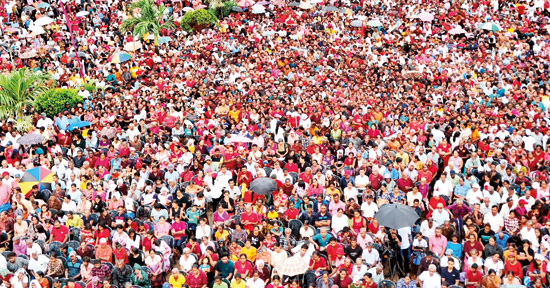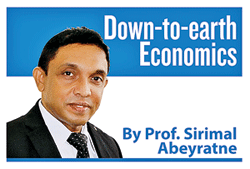Election talks and promises
View(s):This time, however, making some political statements and election promises are quite different from the past experience. Unlike in the past, their repercussions could be utterly disastrous and more disastrous than in the past because of the economic crisis that we plunged into after the COVID-19 pandemic.

Crowds at an election rally.
Having said that, investigating the underlying economics of political statements and election promises and informing the electorate is a national duty, I believe. In most of the cases, they are aimed at touching the feelings and emotions of the electorate rather than guiding them to use their brains. However, I only pick up what I want to refer to, while I am not interested in referring to their authors.
The historical episode of election promises is “innovative and competitive”. You must find the most effective things for the promises, while the others must try beating it with better things!
Crisis and corruption
There are two critical issues emerging from the election heat this time: the economic crisis and the corruption problem. I have no disagreement with these two issues taking priority, but I do have a disagreement with two approaches to them.
 One approach is the focus on corruption only without any reference to the economic crisis. It implies that the major issue that the nation has faced with today is the corruption in the past. Accordingly, correcting it would pave the way for the country to progress and become prosperous!
One approach is the focus on corruption only without any reference to the economic crisis. It implies that the major issue that the nation has faced with today is the corruption in the past. Accordingly, correcting it would pave the way for the country to progress and become prosperous!
It also implies that corruption is the underlying cause of the economic crisis. Corruption has played a role in it, but the major underlying cause of the crisis is the “policy errors” that have gradually increased the country’s vulnerability to external shocks. We must understand an economic fact that “crises build up slowly over time, but the collapse is sudden”.
Stolen wealth
The second approach refers to a famous political statement that the “thieves” will be caught and their stolen or ill-gotten wealth will be confiscated. This is a great move anyway, but the thieves also know “how to both keep that wealth and their names safe”.
There are international experiences from countries such as the Philippines, Nigeria, Tunisia, and Ukraine – the countries that have taken steps to convict the corrupt politicians and bureaucrats as well as to confiscate the stolen and ill-gotten wealth. However, their experiences suggest that this was a lengthy process that takes decades to complete. If this is the case, nobody would dare to anticipate that we should postpone all our urgent needs and wait until we catch the culprits and bring the stolen wealth back to the country.
The important question is, while engaging in corruption problems, how to address the economic crisis on the one hand; and how to prevent future corruption through better regulatory and institutional mechanism on the other hand. It would be worthwhile if the electorate could be informed of both these matters as well.
Donors to elections
Seeds of corruption are already embedded in democracy while elections are one of the areas in which such corrupt practices continue to rise in Sri Lanka. Politicians and their parties must spend many billions of rupees not only to meet the expenses of election campaigns but also to finance free distribution of goodies aiming at buying votes.
Where do those billions of rupees come from? A recent data chart from the US shows the donations by people attached to various government agencies, organisations and companies to the US presidential candidates at its 2020 elections. The original source of data was the US Federal Election Commission.
Among the top-20 donors to Joe Biden, apart from the US government, there were prominent brand names such as Alphabet (Google), University of California, Microsoft, Amazon, Facebook and Apple; the highest donation was from the people from the Alphabet company which was US$ 1.7 million.
Compared with Joe Biden’s receipt of donor contributions, the highest amount that Donald Trump has received was much lower – as low as $240,000 from the people in the US Postal Service. Apart from some government agencies, Trump has received donations from people attached to the companies such as Wells Fargo, The Villages, Bank of America, Walmart Inc., Delta Airlines and Boeing.
Details of election donors
The irony is that donations to politicians in the US are transparent as such data are in public domains so that there is no secret. But in
Sri Lanka, it is mostly a secret and perhaps, an open secret. A new law passed in 2023 – Regulation of Election Expenditure Act No. 03 – contains provisions to reveal the particulars of donors to the candidates and political parties, including their tax information.
However, I am not sure which candidates or their political parties have complied with the law and revealed to the Election Commission about their donors for the distribution of goodies to the electorate and for financing election campaigns.
Based on the Act, a recent Gazette notification published by the Election Commission imposed an upper limit on spending for election campaigns to Rs. 1.87 billion. The information received by the Election Commission, if it had ever been so, is yet to be revealed. If any presidential candidate or their political parties set the example to remain corruption-free, it is their legal duty and moral obligation to comply with the Regulation of Election Expenditure Act too.
Consumer prices
Apart from the distribution of free goodies to the voters and their families during the pre-election times, one of the major election promises is to reduce our “exorbitant consumer prices” after winning the elections. Not a new one, as it has been there throughout our history, but this time it bears special importance.
The increase in consumer prices is the “nail on the head” in the current election campaign. The entire nation was hit by the unprecedented price hikes during the past three years. The price issue was created by the high inflation in 2021-2022, rupee depreciation against the dollar, and supply shortages in the local markets. In additions, the government policies of raising taxes and setting of “cost-reflective prices” in the first half of 2022 also played a major role.
Cost-reflective prices were applied mainly to fuel, gas, electricity and water raising not only the consumer costs directly, but also the production and distribution costs causing general price hikes indirectly. Accordingly, the consumer costs were hit by both the crisis and the policy responses to the crisis.
What are the realistic possibilities to return to the consumer prices that people enjoyed prior to the economic crisis? In the first place, the government reversing the “cost-reflective prices” of fuel, gas, electricity and water to their pre-crisis level is one possibility.
That’s exactly what we have been practicing throughout our election history making such state-owned enterprises (SOEs) non-viable commercial entities, causing budget deficits and accumulated losses and debts, and contributing to the current economic crisis. Therefore, there is no possibility at all to set the prices at their pre-crisis levels.
Realistic promise
There are, of course, other ways to deal with the issue of high consumer prices in the country, but not through the prices controlled by the government. The first step is to control inflation, which has already been achieved with better fiscal and monetary management.
Secondly, there is a favourable impact on price reduction by improving efficiency and reducing the costs. These programmes too are already in progress through the restructuring of such SOEs dealing with public utilities and services. Some of the efforts are already reaping the fruits of reforms. For instance, the Ceylon Electricity Board has already made profits in the first half of the year 2024, and paid all its delayed dues to the private suppliers and settled part of its accumulated debt to the banks and to the Ceylon Petroleum Corporation.
Finally, it is the rising incomes of the people that can cope with higher prices. Therefore, it is worthwhile if the electorate can hear more about the policies and strategies to raise people’s incomes within the next five years.
(The writer is Emeritus Professor of Economics at the University of Colombo and can be reached at sirimal@econ.cmb.ac.lk and follow on Twitter @SirimalAshoka).
Hitad.lk has you covered with quality used or brand new cars for sale that are budget friendly yet reliable! Now is the time to sell your old ride for something more attractive to today's modern automotive market demands. Browse through our selection of affordable options now on Hitad.lk before deciding on what will work best for you!


